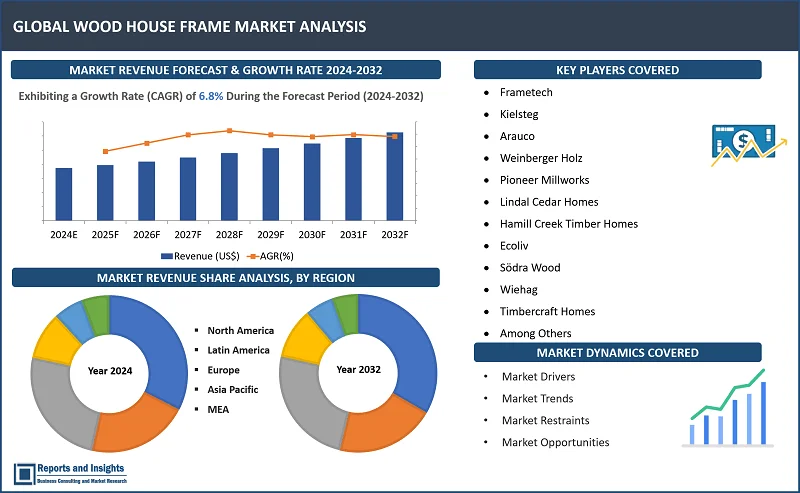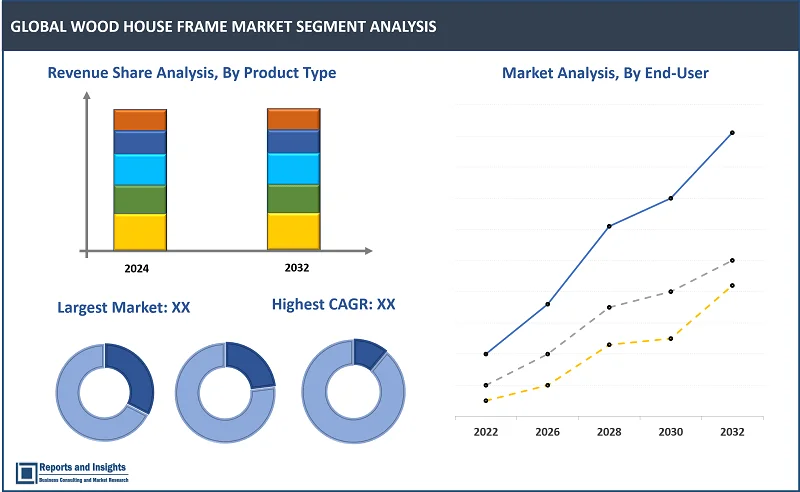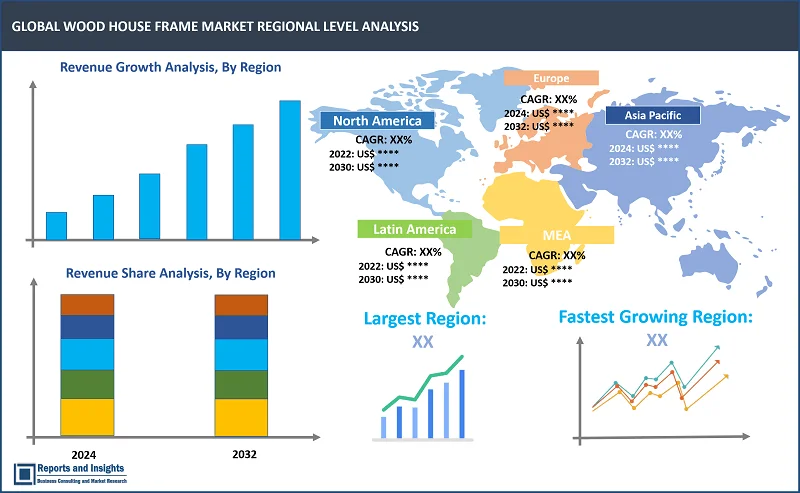Market Overview:
"As per Reports and Insights analysis, the global wood house frame market is expected to register a revenue CAGR of 6.8% during the forecast period of 2024-2032."
|
Report Attributes |
Details |
|
Base Year |
2023 |
|
Forecast Years |
2024-2032 |
|
Historical Years |
2021-2023 |
|
Market Growth Rate (2024-2032) |
6.8% |
A wood house frame serves as the foundational structure in residential buildings, composed primarily of wood-based materials. Consisting of vertical studs, horizontal beams, and diagonal bracing, this framework provides essential structural support for floors, walls, and roofs. Common materials include dimensional lumber for studs, engineered wood products like laminated veneer lumber for beams, and plywood or oriented strand board for sheathing and bracing.
Wood house frames find extensive application in residential construction, offering a cost-effective and sustainable solution. These are widely used during construction of single-family homes, multi-family dwellings, and low-rise apartment buildings. The advantages of wood frames include cost-effectiveness, design flexibility, ease of construction, natural insulation properties, and favorable seismic performance. Also, the renewable nature of wood aligns with sustainable building practices, making it an environmentally conscious choice.
The global wood house frame market has been registering steady revenue growth as a result of rising construction demand, particularly in residential and commercial sectors. Increased consumption can be attributed to sustainability, cost-effectiveness, and aesthetic appeal of wood and focus on more eco-friendly materials in construction. Advancements like prefabrication enhance efficiency, reducing construction time and costs, and initiatives for sustainable forestry and reduced carbon footprint are factors contributing to rising use and popularity of wood in housing projects in an increasing number of countries. Advantages include energy efficiency, design flexibility, and a connection to nature. Analysis and insights underscore resurgence of wood as a preferred construction material, highlighting its potential to reshape modern building practices sustainably.

Wood House Frame Market Trends and Drivers:
Sustainable Construction Trend: Rising awareness of eco-friendly benefits and environmental concerns are driving a shift towards sustainable building materials. Wood house frames, being renewable and carbon-sequestering, align with this trend, attracting eco-conscious consumers and boosting market demand.
Urbanization and Housing Needs: Rapid urbanization is supporting demand for housing and infrastructure and use of wood frames offer a quicker construction process, addressing the urgent need for affordable, efficient, and quality-built structures.
Technological Advancements: Prefabrication, digital design tools, and automation enhance wood frame construction efficiency. This reduces labor costs, accelerates project timelines, and improves quality, and increasing traction is contributing positively to revenue growth.
Architectural Aesthetics: Shifting preference for natural and aesthetically pleasing designs is supporting demand for wood frames, which enable creative architectural expressions, attracting high-end and design-focused projects that yield higher revenue margins.
Government Incentives and Regulations: Governments globally promote sustainable construction through incentives and regulations favoring eco-friendly materials like wood. This encourages adoption and is driving incline in market revenue for companies.
Green Building Certifications: Certification programs like LEED and BREEAM encourage builders to use wood frames due to their environmental benefits. Alignment with these certifications enhances reputation, attracting projects with a premium, and positively impacting revenue growth.
Wood House Frame Market Restraints:
Fire Safety Concerns: Susceptibility to fire raises safety concerns, especially in densely populated areas. Stringent fire regulations and insurance premiums could deter builders from choosing wood frames, and this can restrain wider potential for demand and hamper revenue growth.
Perceived Durability: Perceived susceptibility to pests, decay, and weathering can undermine long-term durability of these products, leading to apprehensions among potential buyers and affecting market growth.
Market Fragmentation: The wood house frame market comprises various players, leading to fragmentation and varied quality standards. This can create trust issues and hinder revenue growth due to inconsistent product offerings.
Material Costs and Availability: Fluctuating wood prices and supply chain disruptions impact cost predictability. Unforeseen price spikes and availability issues can make wood frames less attractive compared to alternative materials.
Labor Skill Gap: Crafting wood frames requires skilled labor, and a shortage of trained professionals can hinder adoption. This limitation could result in extended project timelines and increased labor costs.
Regulatory Hurdles: Local building codes, environmental regulations, and zoning restrictions can limit the use of wood frames in certain regions, constraining revenue growth by reducing potential project opportunities.
Wood House Frame Market Opportunities:
Customization Services: Offering tailored design options for wood house frames can attract high-end customers seeking unique architectural solutions, providing an opportunity for premium pricing and increased revenue.
Prefabrication and Modular Solutions: Developing prefabricated wood frame components allows companies to tap into the growing demand for efficient construction methods. This can lead to increased sales through faster project completion and reduced labor costs.
Sustainable Building Consultancy: Providing expertise on sustainable wood frame construction aligns with eco-friendly trends. Companies can generate revenue by offering consulting services to guide clients toward environmentally responsible building practices.
Technology Integration: Developing digital design tools, virtual reality simulations, and Building Information Modeling (BIM) software for wood frame construction can create an additional revenue stream by catering to architects, builders, and developers seeking efficient project planning.
Education and Training: Offering workshops, seminars, and training programs on wood frame construction techniques and best practices can cater to a growing market of professionals seeking to enhance their skills, generating revenue through educational services.
Export and International Expansion: Companies can explore opportunities by exporting wood frame components to regions with rising construction demands. Entering new markets can diversify revenue sources and mitigate risks associated with fluctuations in local demand.
Market Segmentation:

Product Type:
- Timber Frame
- Post-and-Beam
- Hybrid Systems
- Engineered Wood Systems
End-User:
- Residential
- Commercial
- Institutional
Construction Type:
- New Construction
- Renovation and Retrofit
Application:
- Single-Family Homes
- Multi-Family Buildings
- Resorts and Lodges
- Educational Institutions
- Hospitality Sector
Distribution Channel:
- Direct Sales
- Distributors
- Retailers
- E-commerce Platforms
Segmentation, By Region:

North America:
- United States
- Canada
Europe:
- Germany
- The U.K.
- France
- Spain
- Italy
- Russia
- Poland
- BENELUX
- NORDIC
- Rest of Europe
Asia Pacific:
- China
- Japan
- India
- South Korea
- ASEAN
- Australia & New Zealand
- Rest of Asia Pacific
Latin America:
- Brazil
- Mexico
- Argentina
Middle East & Africa:
- Saudi Arabia
- South Africa
- United Arab Emirates
- Israel
The United States stands as the largest market in North America for wood house frames due to a convergence of factors. Abundance of timber resources ensures a steady and reliable supply for construction purposes, and deeply ingrained cultural preferences have made wood a longstanding and preferred building material across the country. This preference aligns with rising emphasis on sustainable building practices, where renewability and lower carbon footprint of wood align with environmental concerns. Also, strong demand for residential properties, driven by population growth, urbanization, and housing needs, positions wood frames as a cost-effective and efficient solution. Architecturally, wood offers unparalleled flexibility, accommodating the diverse range of housing styles and regional preferences prevalent in the country. With initiatives such as LEED certification advocating for sustainable construction, and the incorporation of innovative technologies like advanced prefabrication techniques. As a result of these various factors, the US is expected to maintain dominance among the other country-level markets in the global wood house frame market.
In Europe, some key trends influence sales of wood house frames, one being unwavering commitment to sustainability and heightened environmental awareness. As the demand for eco-friendly construction practices intensifies, the inherent renewability, biodegradability, and lower carbon footprint of wood house frames make the option a natural fit.
Also, the stringent energy efficiency regulations prevalent in Europe play a pivotal role, and with increasing emphasis on constructing buildings that offer superior insulation and thermal performance, wood house frames present an attractive solution, aligning with these regulatory standards and contributing to the creation of energy-efficient structures. Architectural diversity is another influential driver, and Europe has a rich tapestry of architectural styles, ranging from time-honored classics to cutting-edge designs. The adaptability of wood house frames allows for meeting architectural preferences, and this is another trend supporting use of wood in construction.
Investing in China and India is a key strategy for players in the global wood house frame market. Substantially large populations and rapid urbanization positions these countries are lucrative arenas for companies offering products to expand. Both countries are registering robust economic growth, accompanied by increasing incomes and an expanding middle class. This economic transformation translates into surging housing aspirations and greater affordability for wood house frames, which offer a cost-effective solution to the rising demand for housing and infrastructure.
The construction industries in China and India are undergoing significant expansion to accommodate respective population growth and urbanization trend. By channelling investments into wood house frames, stakeholders can align with the demand for efficient, sustainable, and scalable construction methods. Also, as environmental concerns gain global prominence, both countries are emphasizing sustainable building practices. Renewability and eco-friendly attributes of wood position it as an appealing choice to meet these sustainability objectives.
Leading Wood House Frame Manufacturers & Competitive Landscape:
The global wood house frame market showcases a competitive landscape characterized by a mix of established manufacturers and innovative entrants. As demand for sustainable, energy-efficient, and cost-effective construction solutions grows, competition intensifies among companies aiming to capture market share and meet diverse consumer needs.
Frametech is renowned for its advanced prefabrication techniques, and its commitment to precision engineering and sustainable practices positions it as a leader in delivering efficient wood house frame solutions. Kielsteg has global presence, and specializes in engineered timber solutions. The company’s emphasis on eco-friendliness, durability, and design flexibility contributes to its prominence in the wood house frame market. Arauco is a major wood products manufacturer, and its expertise extends to wood house frames. The company’s integrated supply chain, incorporating sustainable forestry practices, allows offering of competitive solutions to a wide range of projects.
Weinberger Holz is a pioneer in timber construction, and has reputation for innovative wood house frame solutions. The company’s focus on energy efficiency and modular construction is a driving force behind its competitiveness. Pioneer Millworks is notable for reclaimed wood solutions, and brings a unique aspect to the market. The company’s commitment to sustainability and creativity caters to the niche demand for distinctive wood house frames.
The competitive landscape is marked by ongoing technological advancements, product innovation, and a push for sustainability. Leading manufacturers are investing in research and development to enhance prefabrication processes, making wood house frames more efficient and cost-effective. Innovations such as computer-aided design tools, digital simulations, and sustainable coatings are differentiating factors.
Also, partnerships with architects, builders, and developers to showcase the benefits of wood house frames are becoming more prevalent. Establishing certification standards for eco-friendly construction, like LEED and BREEAM, also plays a pivotal role in influencing competitive positioning.
While established manufacturers hold significant positions, new entrants and emerging companies with fresh ideas and approaches are making a difference. As sustainability concerns intensify and global construction trends evolve, competition in the wood house frame market is expected to remain dynamic, encouraging further innovation and customer-centric solutions.
Company List:
- Frametech
- Kielsteg
- Arauco
- Weinberger Holz
- Pioneer Millworks
- Lindal Cedar Homes
- Hamill Creek Timber Homes
- Ecoliv
- Södra Wood
- Wiehag
- Timbercraft Homes
- Natural Element Homes
- Honka Log Homes
- Riko Hiše
- Honkatalot
Research Scope
|
Report Metric |
Report Details |
|
Market size available for the years |
2021-2032 |
|
Base Year |
2023 |
|
Forecast Period |
2024-2032 |
|
Compound Annual Growth Rate (CAGR) |
6.8% |
|
Segment covered |
Product Type, End-User, Construction Type, Distribution Channel |
|
Regions Covered |
North America: U.S. & Canada Latin America: Brazil, Mexico, Argentina, & Rest of Latin America Asia Pacific: China, India, Japan, Australia & New Zealand, ASEAN, & Rest of Asia Pacific Europe: Germany, The U.K., France, Spain, Italy, Russia, Poland, BENELUX, NORDIC, & Rest of Europe Middle East & Africa: Saudi Arabia, United Arab Emirates, South Africa, Egypt, Israel, and Rest of MEA |
|
Fastest Growing Market in Europe |
Germany |
|
Largest Market in Asia Pacific |
China |
|
Key Players |
Frametech, Kielsteg, Arauco, Weinberger Holz, Pioneer Millworks, Lindal Cedar Homes, Hamill Creek Timber Homes, Ecoliv, Södra Wood, Wiehag, Timbercraft Homes, Natural Element Homes, Honka Log Homes, Riko Hiše, Honkatalot |
Frequently Asked Question
At what CAGR will the global wood house frame market expand?
The global market is expected to register a 6.8% CAGR through 2024-2032.
Which region holds the largest market share in 2023?
Asia Pacific holds the largest market share in the year 2023.
What are some key factors driving growth of the global wood house frame market?
Market growth is driven by factors such as increasing demand for sustainable construction solutions, rising awareness of wood's eco-friendliness, architectural versatility, and the adoption of advanced prefabrication methods.
What are the primary end-user segments in the wood house frame market?
The key end-user segments include residential, commercial, and institutional sectors. These encompass everything from private homes to commercial buildings and educational institutions.
How do different construction types impact the wood house frame market?
The market is segmented on the basis of construction type into new construction and renovation/retrofit. New construction benefits from the use of wood house frames due to their efficiency, while renovation projects leverage their adaptability.
What applications are driving significant adoption of wood house frames?
Wood house frames find applications in various sectors, including single-family homes, multi-family buildings, resorts, lodges, educational institutions, and the hospitality industry. Their aesthetic appeal, energy efficiency, and sustainability contribute to their popularity.
Who are the major end-users of wood house frame market?
Residential, Commercial, and Institutional are identified as major end-users of wood house frame market.
What distribution channels are prevalent in the wood house frame market?
Wood house frames reach consumers through multiple distribution channels, such as direct sales, distributors, retailers, and e-commerce platforms. This diverse distribution network ensures accessibility for various types of buyers, from professionals to individual consumers.

